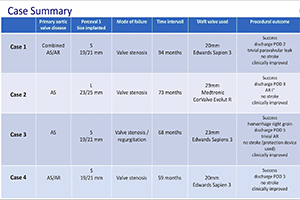A series of four transcatheter aortic valve replacement in failed Perceval valves
Abstract
In recent years, sutureless valves (SV) and rapid deployment valves (RDVs) have become interesting aortic valve substitutes, especially in minimally invasive aortic valve surgery, as they reduce cardio-pulmonary bypass and cross-clamp times. There are two valve types available, the sutureless Perceval and the rapid deployment Intuity valve prosthesis. When these valves fail, besides surgical re-replacement, the valve-in-valve concept has been reported in a small series of case reports. Our own experience includes four cases of failed Perceval valves, in which a balloon-expandable transcatheter valve was implanted in three patients, and a self-expanding transcatheter valve was implanted in a fourth patient. Here, we present these four cases with a focus on the specific valve design of the Perceval valve, as well as on important technical aspects. All cases were performed successfully with clinical improvement. Transcatheter aortic valve replacement (TAVR) as a valve-in-valve concept seems to be a valuable option in selected patients with failed sutureless or RDVs.
Cover






